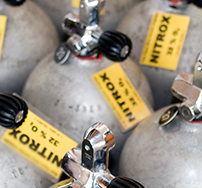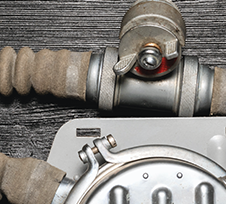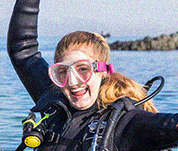Nitrox Plus: The Missing Link…
A NEW APPROACH TO ADVANCED RECREATIONAL DIVING TECHNIQUES This is nothing to do with cavemen, just something that helps to fill a gap in recreational training from RAID. The brand new RAID Nitrox Plus Course is designed for recreational divers who wish to extend their underwater time and gain insights into technical diving. But without investing in tonnes of new kit. Nitrox Plus provides the essential knowledge and skills to help divers explore new depths while managing the benefits and considerations of nitrox use more effectively than ever. The plus is that this is a two cylinder course which provides the security of extra gas when your adventure takes you to the recreational limit of 40 metres/150 feet. This is also a great opportunity to learn the most efficient way to carry a second cylinder of bottom gas… a great strategy when diving beyond 30 metres/100 feet, or so! This course focuses on using nitrox for dives with a maximum safety stop of 10 minutes and incorporates a conservative gradient factor to ensure safety. Nitrox Plus kit configuration can be:Single cylinder (with or without H or Y valve) of adequate capacity for the planned dive.One standard primary regulator setup fitted with long hose including piston clip.One low-pressure (LP) inflator hose for BCD and dry suit (if appropriate). LP connectors must be interchangeable.One backup regulator with standard hose fitted with neck bungee.One SPG with piston clip.Stage cylinder holding suitable gas volume of bottom mix for planned dives.Stage cylinder rigging kit.Cylinder marking for MOD, Diver Name and Mix (labelled as per RAID cylinder marking standards).Suitable DIN regulator with SPG on a short HP hose.A recreational BCD that has capacity to carry a stage cylinder. OR Wing, plate and harness with single tank adaptor.Personal dive computer.Backup computer or depth dive timer.Wetnotes or wrist slate or finger slate.Primary SMB.1 x reels or spools with adequate line length for the dive depth.2 x cutting devices.Backup Mask.Light where appropriate.Smartphone, tablet or laptop with decompression software (instructor must have, optional for students).Access to an oxygen analyzer. SEE NEW DECOMPRESSION DIVER COURSE HERE>>>
New Training Flowchart
NOVEMBER 2024 UPDATE This updated course listing reflects changes we’ve made to the logical flow of Dive RAID International training progression including the introduction of Nitrox Plus and Decompression Diver. These new courses bridge the distance between Tech and Rec. Dive RAID International promises its members and their students high quality, skills-based instruction that’s always being added to and improved. That’s the nature of technology and at the core of safe, fun, and inclusive diving. That’s The RAID Way™. DOWNLOAD A PDF OF THIS TRAINING FLOWCHART HERE>>>
You Told Us… We Listened!
RAID HAS REARRANGED ITS TECHNICAL DIVING PATHWAY RAID has been helping divers live their dreams since we opened our doors. We’ve lost count of how many students we’ve coached from their first open water cert. to deep trimix CCR and beyond. But times change and the feedback we have been getting asked us to streamline things to reflect what divers making the transition from Rec to Tech are asking for today. And here is the answer to those requests. We’ve shuffled our course outline making it more logical, and better suited to what our students need. The secret behind the shuffle is the addition of a totally new bridging program: NITROX PLUS. DOWNLOAD A PDF OF THIS FLOWCHART HERE>>> VIEW THE MODIFIED TRAINING FLOWCHART HERE>>>
OC and Rebreather Divers: Quick Quiz

EVERY DIVE SHOULD START WITH A {please fill in the correct answer} A good pre-dive checklist must include all the usual suspects: from being correctly weighted to following a sensible dive plan. That’s a given and a piece of advice that every diver should follow without fail. However, a GREAT pre-dive checklist has all that but also includes everyone performing an S-drill before venturing any deeper than five or six metres. So, if you included S-Drill or Safety Drill in your answer, you win. Congratulations. Most RAID-trained divers know that an S-Drill is an essential pre-dive skill that confirms everyone in the dive team can safely and quickly hand-off a working second stage (and the breathing gas it delivers) to a diver who is out of gas — simulated or real. The exercise — completed in a few moments and more than worth the small time investment it takes — certainly makes sure that gas can be shared with a buddy cleanly and quickly in a time of stress. It also confirms that backup regulator hoses are free and untangled, and not caught in other peices of equipment. A properly performed S-Drill has the added advantage of checking equipment is bubble-free (no leaks), and that every diver in the team have no issue maintaining buoyancy control and trim while the skill is performed. (Which in turn confirms there are no issues with BCDs or wings.) Once something only cave divers bothered to do, at RAID, the S-Drill is considered an essential skill for every diver (except freedivers). It’s appropriate for all diving environments, and for divers planning to take their adventures to every depth. The take-home message, RAID certified diver or not, please make sure you include an S-Drill in your pre-dive checks every time you dive. Watch the videos linked to below for tips and demonstrations of standards open water S-Drills.
Aiming for Harmony is the Best Option

THE HIDDEN POWER OF A STUDENT/INSTRUCTOR AGREEMENT Managing customer expectations is a critical part of any business whether it’s for a mega multinational employing 50,000 souls around the world or a one-person outfit selling tacos around the corner. It’s particularly important for anyone working in a service industry: someone delivering dive instruction for example. And although it’s rarely a topic in the average scuba instructor program — and even less an issue discussed with the average consumer signing up for ‘dive lessons’ — the importance of some sort of contract can’t be overstated. A student/instructor agreement is probably the most overlooked and underrated piece of the ‘keeping everyone happy jigsaw puzzle’ in the dive industry. So, let’s start remedy that situation. First step is to drill down on its function, and look at the purpose of a student/instructor agreement and what it protects…. for both instructors and students. The short answer is that a basic agreement is a type of simple business contract. It defines what the student can expect from the instructor and vice versa. It is what’s called a transactional contract. Unlike when we buy (or sell) a tangible product — a new drysuit or a regulator or pair of fins for instance — when we buy a service such as a scuba course, the ‘product’ is not as obvious. Dive instruction is essentially an exercise in changing a student’s behaviour based on new knowledge and understanding. Modifying the way a student thinks and acts is not an easy thing to gauge; but an instructor is asked to. Sure, the course standards define what the course is all about. These standards may also state what skills a student must be taught and must demonstrate to earn a pass, but often that definition does not go far enough. In its simplest form, an agreement is in place to make sure that the student knows what they are paying for (a tangible roadmap pointing out the start and finish), and the instructor knows what the student expects. In the remote event of a dispute, it acts as a sort of reminder and a checklist. “We agreed on this, this, and this…” which makes it easy — or easier — to say the job is done to everyone’s satisfaction. More often, when no dispute is involved, it is a simple piece of marketing that allows an instructor (or dive shop owner) draw a hard line between what they offer compared to the “folks down the street.” At least, that’s the goal. SIMPLE OR COMPLEX, YOUR CHOICE A very basic agreement could be a copy of the course standards with a price attached, signed on the bottom, with a note saying that this is what the instructor and the student have agreed is going to happen. At the other end of the scale is a document in triplicate that reads like a UN peace treaty detailing every step of the way from when the student walks into the shop’s front door until they’ve dried their hair at the end of the last dive… and beyond. For most of us, something in between does the job just fine. Exactly how far from one end of the spectrum or the other an agreement sits is essentially a question of comfort-zone: the instructor’s and the student’s. What also may influence its position, is what kind of program the agreement covers. An agreement for a RAID Try Dive would be very different to one for a Rebreather Instructor Trainer course, for example. A good compromise for most cases would detail the services being sold and the goals of the instruction that’s being paying for. This should include a list of skills and techniques the student will be asked to demonstrate in order to earn a pass mark. Next should be a course schedule. The number of hours/days, how much time in a classroom or ‘workshop,’ when the course starts and a budgeted end date, and anything related to the calendar and clock. For example, it should cover weather-related cancellations and delays if those are possibilities. This is also the chance to mention punctuality. This is especially important when classroom space is at a premium or charter boats and dive site access is a factor. Any circumstance where late equals extra charges. And of course an agreement must detail professional fees, including what expenses are billable (this might include travel, accomodations, consumables and the like). These are what most would consider the essential minimums. For multi-day programs, listing waypoints — student progress towards certification — might also be fair for the student and the instructor. Bureaucracy and the burden of paperwork is one of the biggest turnoffs for most of us but the protection a student/instructor agreement offers (both parties), and the potential to avoid time-consuming distractions and so called ‘he-said-she-said’ arguments add serious weight to the benefits of using agreements in your business.
Every Little Helps… and sometimes a little help means a whole lot!

SELLING NITROX TO THE DIVERS WHO NEED IT MOST… We should start by saying that subheading contains a misleading statement; every diver needs nitrox. Air is good for pumping up bike tires, but the correct breathing gas for the majority of diving is nitrox or trimix. Of course, there are no absolutes in scuba diving and there are exceptions to every ‘rule.’ For instance, there are spots across the RAID network where nitrox is simply unavailable. If that’s your case, accept our apologies; we do understand that diving without nitrox is better than not diving. By now most dive operations, dive pros, and dive agencies have promoted the advantages of breathing nitrox clear and bold: Reduced Nitrogen Absorption: Because it contains less nitrogen, divers using nitrox can experience less nitrogen buildup in their bodies. This can help decrease the risk of decompression sickness (the bends) on every dive. Extended Bottom Time: Nitrox allows for longer bottom times at certain depths compared to air, making it ideal for dives where extended exploration and adventure is called for. Shorter Surface Intervals: Some dive plans may allow for shorter surface intervals between dives when using nitrox, depending on the specific mix, depth, and number of dives planned for the day. And even a cursory Google search turns up enough five-star ratings to help convince the biggest skeptics. But there’s one advantage to taking a nitrox class that isn’t talked about nearly enough. It’s one that is a real advantage to every diver, but especially the “more experienced” ones had to move placoderms out of the way to get into the water. And oddly it has little to do with the potential health benefits that nitrox may deliver to older divers. NITROX TRAINING IS A FANTASTIC GENERAL REFRESHERTaking a nitrox class reminds divers about some of the basics around dive planning. A good nitrox course (like this RAID specialty) walks the student through some of the simple but critical steps that help to make a dive plan relevant and safe. A nitrox dive tends to have well defined depth and time limits. The planning process for a nitrox dive is also more likely to include working closely with a dive buddy (or buddies) before getting wet. We’re not suggesting that experienced divers tend to have a more ‘ad-hoc’ attitude towards their recreational dive plans, but nitrox training can enhance the diving experience for older divers whose knowledge and safety procedures could use a little nudge in the right direction. Now’s a great time to your experienced diver mailing list with more information about nitrox programs.
“Well that explains everything…”

Marketing SCUBA is easier than ever

THOSE WERE NOT REALLY THE GOOD OLD DAYS AT ALL Someone brought an old travel brochure into the DRI office last week. It was about scuba diving in the ‘British Caribbean’ and was a classic piece of pre-internet marketing; definitely from a different era. It would be pretty easy to totally right it off dismissing it as irrelevant in today’s market, but — as old and completely out-dated as it is — it does have something interesting to tell us. Namely, there are so many more options for us to take advantage of now compared to when this antique was printed. You may be a little antique yourself and remember that back in the early 1990s, when it was printed, about the only option for a dive shop was to print flyers like this one, hand them out or snail-mail them to hundreds of customers — at a considerable cost per unit — and hope a significant few signed up for a trip. Worth remembering, or learning, that 30 years ago, there were no blogs, online videos, and social media posts to share informative content about scuba diving, and certainly no affiliate programs to build interest with other local retailers. In short, there was no easy way to highlight the benefits of diving, its unique experiences, the adventure it offers, any pertinent safety tips, and no personal stories on social media to help build a sense of community; nothing to share any of the excitement and beauty of diving. Also, there was no nitrox, way fewer specialty programs, no “technical” diving, no overhead training — like advanced wreck or cavern and cave — and aids like oxygen administration and compressor operator courses were totally off-limits. And nothing to promote rebreathers, DPVs, twinsets or sidemount. Nothing beyond the basics to up-sell and retain customers. Plus, the brochure mentioned nothing about special events, like equipment workshops, in-store book signings, or show-and-tell nights promoting upcoming trips. (Of course, back then, there was no simple way except perhaps a sign in the store window, to let people know any of this was happening.) It’s true that the basic rules of marketing are unchanged. It’s still the case that selling everything from a large-screen TV and flat box furniture to a scuba diving course primarily involves identifying your target audience, recognizing what they are looking for, and then targeting your message to appeal to them. And in the diving world we all understand that another constant is that if your local diving is focused on tropical reefs and big pelagic wildlife, your message (and the courses and equipment you push) will not be the same as the shop within an hour’s drive of fantastic wooden wrecks preserved by four-degree freshwater. All that and perhaps that dive trips to exotic destinations have a universal appeal, and hopefully always will. You may not be taking full advantage of all of the online and associated marketing strategies available in 2024. You may not use smart apps and CRM software to regularly engage your customers. And you may not have learned to adjust your approach based on feedback and results from previous marketing efforts — easily captured by a whole raft of online tools — but we are sure that you have a much easier time of it when a four-colour printed brochure was all there was! We’re not suggesting marketing is easy today, but it is a whole lot easier than in the good old days.
For Divers by Divers…

ISN’T THE RAID WATCHWORD TRUE OF ALL AGENCIES? One of our shareholders was recently asked to respond to a dive instructor who questioned our call to join Dive RAID International because it’s an agency built by divers for divers. He claimed that statement is “verbose [sic] and a claim to exclusivity that needs some validation and verification.” Challenge accepted! Our shareholder wrote back: “Thanks for your question! While it’s true that many agencies have been founded by divers, what makes RAID different is that our philosophy and operations are driven entirely by divers, for the benefit of divers. “Unlike some agencies where business or corporate interests tend to influence decisions, at RAID, everything from course development to instructor support is shaped by active, experienced divers who understand the needs of the community firsthand. “Our goal isn’t just to certify divers; it’s to enhance the entire diving experience through constant innovation, flexibility, and by putting divers at the heart of what we do. That’s the difference we stand by!” In the proverbial nutshell, our shareholder summed up EXACTLY what RAID is all about. If she’s had more space, she might have added, all that and everything related to following a skills-based, inclusive approach to training and doing business that seeks to bring value and positive change to the dive industry. And if that sounds like your kind of outfit… WHY NOT JOIN US!?
Protected: This program risk management insurance we hope you never have to claim… but it’s essential to have.
There is no excerpt because this is a protected post.

